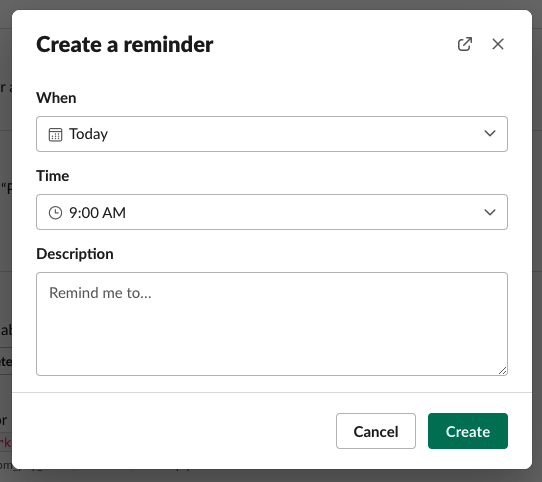5 Ways to Leverage Slack Reminders, With Examples
In this blog post, we'll show you five ways you can leverage Slack reminders to stay organized and productive.


If you're like many busy professionals, you probably have a lot on your plate, and it can be easy to forget important tasks or deadlines. That's where Slack reminders come in. Slack reminders are a useful tool that can help you stay on top of your to-do list and make sure you never miss an important deadline. In this blog post, we'll show you five ways you can leverage Slack reminders to stay organized and productive. We'll also provide examples of how to use Slack reminders to make the most of this powerful tool. Whether you're a busy entrepreneur, a project manager, or a team leader, you'll find plenty of valuable information in this blog post.
Let's get right into the many ways Slack reminders can be used by looking at a few examples. We're going to start things out simple by looking at a very basic example.
1. Setting a Reminder for Yourself
Sometimes you just want to remind yourself to do something later. Slack is a good place to set this reminder, because more likely than not, you'll have Slack open almost all the time. Follow these steps to set a Slack reminder for yourself.
1. In the chat box, type /remind
2. Fill in the details for the reminder
That's super simple! Typing /remind will show a Create a Reminder popup, like the one seen below.

Once you fill in the information, you can just click on the Create button to save the reminder. Once the reminder has been saved, Slack will show a message giving you the option to delete the reminder or view all the reminders.

You can also skip the popup entirely and set the reminder by using only the /remind command. You just need to give it a little more detail. You can do that in the form of /remind "text of the reminder" at time and date. For example, to set the previous reminder, you'd write: /remind “Write blog post about Slack reminders” today at 11pm. And that's how easy it is.
Once the time comes, Slack will send you a message about the reminder and give you the option to either delete it or snooze it for a while. If you snooze it, Slack will just remind you again when the snoozing period is complete.

2. Set a Reminder to Reply to a Message at a Later Time
I'm a remote worker, and there's about a five-hour difference between me and the rest of the team. Because of the time difference, I don't need to take action right away on some of the messages that come through. Sometimes I can deal with them the next day. So I rely heavily on Slack's ability to remind me about a message at a different point in time.
Setting a reminder is very easy:
1. Hover over the message you want a reminder for
2. Click the message options button on the extreme right, and then select Remind me about this
3. Select when you want to be reminded about the message

Just like a regular reminder, once the time comes, Slack will helpfully remind you about the message and give you a link to quickly go back to the original message.
3. Set a Reminder that Repeats Every X
I have an old printer that will jam if it doesn't do at least one print job a week. Given that this is 2022 and I don't really need to print that often, I tend to forget about it until the time comes when I need to print something and the printer doesn't work. To get over this minor annoyance, I have a repeating reminder on Slack which reminds me to make a printout every week.
To set a reminder that repeats every hour/day/week, just type it in this form: /remind "Something to do" every day. The "every day" part could be an hour, day, week or any unit of time Slack recognizes. And you can also give it a time if you want the reminder to trigger at a specific time.

You can even have Slack remind you every year!

4. Set a Reminder for Your Team
Another good use case for reminders is to remind everyone on your team to action something. For example, Thursdays are when my team refines our work for the next sprint. It's good practice to go through our pending tickets and figure out which ones need to be discussed.
Setting a reminder for a channel is almost the same as before. There's a tiny change in the syntax. To remind your team to prepare their tickets every Thursday, you can type:
/remind #team-name "Prep tickets for refinement" every Thursday
Once you do that, Slack shows a little message in the team channel so that everyone is aware a reminder has been set.

And don't forget that you can use this same format to remind just one person. For example /remind @james "Prepare slides for sprint review" on Tuesday will send James a reminder at 9 a.m. on Tuesday. Note that you can only set repeating reminders for yourself or for a channel, not for a specific person.
5. Tweak Your Reminder Time
Readers who are paying attention might have noticed that I don't use the time component in a lot of my reminders. This is because I've set the default time for when reminders should be triggered to be 9 a.m. So when I don't specify a time in the reminder, Slack will send the reminder at the default time. You can set the default time via the Preferences window.

Bonus Example: Managing Your Reminders
Here's a free bonus tip about reminders. You can type in /remind list to view all your reminders.

This will show you all of your upcoming reminders, as well as the ones you've completed. You can then mark them complete, delete them, or even reschedule them for later. You can even create a reminder to clean up your reminders at the end of each week!
Going Beyond Basic Reminders
As we covered in this blog post, Slack reminders are a great tool that can help you stay organized and on top of your tasks. Setting up reminders for yourself and your team ensures that important deadlines are met, and that important discussions don't get lost in the shuffle. With the ability to set recurring reminders and customize the timing and recipients of your reminders, Slack offers a variety of options for how you can leverage this feature to improve your productivity and collaboration.
"Setting up reminders for yourself and your team ensures that important deadlines are met and that important discussions don't get lost in the shuffle."
While this functionality provides a solid base to build upon, Slack doesn't offer much in the way of ticketing and workflow automation. That's where Wrangle comes in. Wrangle provides extra functionality and customizability that's missing for large, cross-functional teams. These tools tie in seamlessly with Slack's solid notification and messaging platform, and they provide great value for your teams.
If you’re using Slack for managing an array of business processes, reminders will fall short. Wrangle provides users with tools that turn Slack into a productivity powerhouse. You can deploy Wrangle in a number of ways. Many of our users are replacing their antiquated IT help desk and allowing their users to manage their ticketing in Slack with some help from the Wrangle app.
Wrangle allows your team to make requests that generate tickets instantly in Slack. Your users make their requests in the conversational platform they work daily, while your agents have an easy-to-use web dashboard to find, sort, and prioritize requests. Tickets are intelligent because they are backed with workflow automation that uses conditional logic. Workflows can automate your more mundane processes and tasks.
But ticketing is only one side of the coin. Wrangle can be used to automate a variety of business processes. Our customers use Wrangle to automate
- Document approvals
- Creative reviews
- Employee onboarding
- Customer onboarding
- PO / Procurement
- Contract management
- Expense management,
- Bug reports
If you have a process that is occurring in Slack, Wrangle can transform your work into an efficient BPM machine that can be measured and tracked.
Ready to see Wrangle in action? Request a demo today. Better yet, add Wrangle directly to Slack and experience productivity gains shortly thereafter.
This post was written by John Pereira. John is a technology enthusiast who's passionate about his work and all forms of technology. With over 15 years in the technology space, his area of expertise lies in API and large-scale web application development and its related constellation of technologies and processes.

- Try Wrangle free for 14 days
- Turn messages into trackable tickets
- Build a scalable help desk



Turn Slack into a productivity powerhouse with Wrangle
Create a scalable helpdesk in Slack. Automatically turn messages into trackable tickets and provide faster, more transparent service to your colleagues and customers with Wrangle — Try it free!






